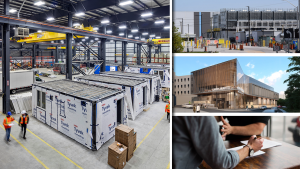The Canadian Pavilion at Expo 2020 in Dubai combines elements from the Canadian landscape and Arabic architecture to reflect the expo theme, Connecting Minds and Creating the Future.
“There is a story to it,” said Wissam Ayoub, senior vice-president of EllisDon Middle East and North Africa. “It’s inspired by the theme of expo which is really about connecting minds and connecting cultures.”
Expo 2020 was supposed to be held last year but was delayed due to the COVID-19 pandemic. For this expo, and for the first time in World Expo history, every participating country has its own pavilion. EllisDon was selected to design, build and maintain the Canadian Pavilion working with consortium members Moriyama & Teshima Architects, Amana, Lord Cultural Resources, Hatch, Kubik, Thornton Tomasetti and NGX.
Located in the sustainability section of the Expo grounds, the pavilion officially opened to visitors earlier this month following a grand opening ceremony and ribbon cutting. The pavilion consists of two main elements: the architectural elements on the outside and the 360-degree theatre experience on the inside.
It’s wrapped in a wooden geometric lattice façade, a reference to the traditional Mashrabiya, which is used in the region for shade from the sun as well as privacy, explained Ayoub.
At the same time, it’s also inspired by the landscape of Canada and sustainability. The building is engulfed with Canadian wood, Douglas Fir, and uses recyclable materials and solar power.
The circular shape of the pavilion is also a universal symbol of unity and inclusivity.
Inside is the public presentation piece of the pavilion which takes visitors on a journey that “highlights the links between Canada’s natural beauty and resources, the power of its Indigenous peoples’ traditional knowledge and the diversity and dynamism of Canada’s urban centres, which are engines of creativity, innovation and prosperity,” states the EllisDon website.
“It portrays that in the scenery, the different seasons, talks about the Indigenous people and the culture, the innovation…how we went through COVID and how it impacted our lives,” Ayoub added. “At the end it talks about the connection of people and how they interact together, climate change and sustainability.”
At the main entrance there is an art installation called Traces, created by Montreal-based firm KANVA, which reflects on the uncertainty of the future of ecosystems.
The RFP for the pavilion was issued by the client, Global Affairs Canada, in March 2019 and was awarded to EllisDon in June of the same year.“We started with the initial design stages and stakeholder engagement and design workshops and in October 2019 had the groundbreaking,” said Ayoub. “This was a piece of land in the desert basically. The idea was to finish by October 2020. Everything was moving on schedule and then COVID hit and caused a lot of delays.”
Most of the outer shell of the building was completed in early 2020, but there were some logistic and shipping delays.
“In January and February COVID started so you had some delays in terms of getting labour, in terms of social distancing and safety measures,” Ayoub explained.
“The main challenges were around the last stages of getting equipment in, delays in shipments and so on but we had time so it wasn’t an issue.”
Other challenges involved getting the material for the exterior wood screen shipped and assembled and deciding whether or not to install it in advance.
“Here in Dubai it goes up to 50, 60 C in the summer and the sun gets really strong and installing it two summers in advance might discolour the wood,” Ayoub explained. “We delayed the installation of the screen for one summer just to miss one cycle of extreme heat and sun and humidity.”
While much of the project was executed by the EllisDon team in Dubai, most of the design and public presentation development was done in Canada.
“Global Affairs Canada, the design team, the architects were Canadian. We have a design management team in Canada, so it was a combined effort between the Dubai office and Toronto and Ottawa as well,” said Ayoub.
The pavilion will be open to visitors until March 2022. In addition to the public presentation, the pavilion also offers a VIP or event space that will offer educational programming. It is unclear what will happen to the pavilion in the future.
“The legacy is not decided yet,” said Ayoub. “Initially the contract was to dismantle the pavilion after but there is talk about potential use after March. The big pavilions in the Expo are permanent pavilions, but the country pavilions, some will remain, some will be dismantled. It remains to be seen it but that is being discussed.”
Follow the author on Twitter .











Recent Comments
comments for this post are closed